I'm no pro at making templates (all of my templates are hand-drawn, then scanned & I really need an intensive course in Photoshop) but I do have some tricks that might help you or may inspire an idea... so here's a look inside of my crazy brain:





Making Templates (the ABC version):
A) Draw something on cardstock (like a flower, heart, bird)
B) Cut it out, lay on patterned paper/cardstock & trace it
C) Cut out as many as you'd like & use 'em
ok, easy version over...here's the craziness...
Making Templates
(the A to Z version):
Supplies I use:
- Pencil, pens, eraser, white out (or a signo gel pen in a pinch)
- Printer paper, white cardstock
- Good scissors
- Tracing paper/Vellum
- An all-in-one printer/scanner/photocopier
- Photo editing software
- Store bought boxes to unfold & trace
- A mirror
- A light box (or sunny window & masking tape)
- Sticky notes
Steps for making templates:
A) Prepare B) Work your concept & Draw C) Refine your template
A) Prepare
1. Build your concept: Are you looking for a box? A shape to use as a scrapbook mat for photos? A shape to use on cards? A 3D flower? Brainstorming is a good way to push your creativity.
One step I like to do in working the concept is to see if it already exists. If there's the perfect 3x3 box out there why reinvent the wheel? (I made the mistake of spending hours making this set of templates when this lovely template set already existed.)
2. Start by doodling: (I find doodling to be a kind of visual brainstorming) Use pencil or pen on a scrap of paper & let your mind go free. As you can see by the mess I made here, it doesn't have to be tidy to be useful:
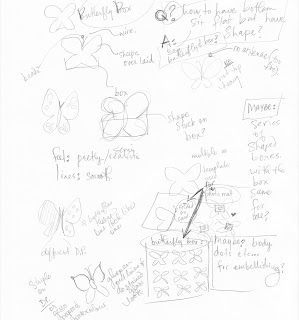
3. Research your subject (for instance look for butterfly shapes on-line & revamp yours if you like) OR if your making a box, look at how other boxes templates are laid out. (You can do a google image search for box template or butterfly template.) This'll save you reinventing the wheel if the thing you want has already been made into a template.
B) Work your concept
--> Pick your favourite doodle/concept & work it
You may want to consider these questions:
You may want to consider these questions:
- How big will it be? (Keep the size of your scanner bed in mind--or consider the size of paper you have to work with 12x12 or 18x18<---heard there's a new Martha Stewart paper line this big.)
- What feeling will it have? (Whimsical? Traditional? Funky? This seems an odd question but it helps you when you are drawing. A whimsical shape can have "flaws" that are part of its charm. The lines you draw in a Funky template may be morewobbly or playful.)
(These may seem obvious but...)
- Start in pencil & have a good eraser handy. I love a mechanical pencil for it's fine line & graphite that's not too soft (so less smudging)
- Use a good ruler. I like Tim Holtz's design ruler, because I can use the grid in it to check if lines are parallel or not. It also allows you toit make sure things are equidistant (it has a center mark) and you can see if your corners are square, etc.
- One handy trick: first, layout the basic shape by drawing it freehand & then, square it up by using a ruler to draw lines over your original sketch shape.
- Conversely: you can use an perfected outline to work your freehand drawing into. These flowers started out as tracing bowls onto paper to make more perfect circles:
C) Refine your template
To make an organic shape symmetrical, you can either...
A) Draw a shape on a sticky note & trace it repeatedly:
For the template above I drew the flower petal on a sticky note that would fit evenly into the circle & then repeatedly traced that one petal all around the circle.
...or B) Use simple paper folding to your advantage:
Step 1) ...draw your shape & choose your favourite half of your drawing
(my favourite is the right side after reworking it so it no longer looked like a sausage):
Step 3) ...cut it out along the lines of your favourite half (rework it if you need to until you're happy with it):

Step 4) ...trace the cut out shape onto a new sheet of paper in pencil & refine the pencil (erasing/adding where you think it needs it) Add measurements, labels, copyright info, etc......Darken it: Scan it and darken on the computer (described below) or trace it darker:

Step 6)... photocopy or scan it (this ensures that if you make any mistakes in later steps, you can go back to your pencil template.) Here's my scan saved as a jpeg (& darkened in photo editing software):
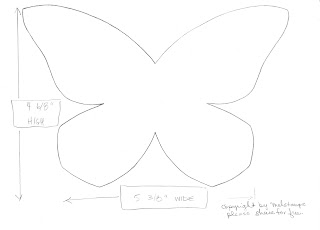 Step 7) Use as is or rework your template however you like. I'm going to print a few butterflies & experiment with designs on the wings & maybe make some other surprises with it. (Hint: If you like butterflies, watch for this one to metamorphose into a butterfly card box soon) ;0)
Step 7) Use as is or rework your template however you like. I'm going to print a few butterflies & experiment with designs on the wings & maybe make some other surprises with it. (Hint: If you like butterflies, watch for this one to metamorphose into a butterfly card box soon) ;0)2 ways I use to darken a template:
A) By computer: [Step 1) Scan & Step 2) Darken.]
- 1. Scan: When scanning your template, I find it useful to save it as both a jpeg & a pdf. You can manipulate the jpeg but the pdf is great since it'll always print in the exact size you made the template (important for envelopes etc...)
- 2. Darken: Open the jpeg from the scan of your pencil-drawn template & darken the image in photo software. I use microsoft picture manager for now.
Annapurna had the brilliant idea to erase mistakes from scanned templates in Photoshop. (I have to learn that!)
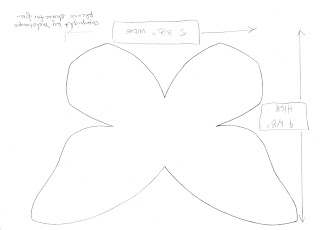
To check for symmetry in a template you can...
- A)...look at it upside down or from the side. Getting another view kicks your right brain aka artsy side of the brain into gear)
- B)...hold it up in a mirror (the reverse image will show you it in a new light)
- C)...photocopy it and layer the original & the copy on a light table (or taped onto a bright window.) You'll be able to see if the super-imposed lines line up.
Scanning/photocopying templates allows you to:
- A) Alter it fearlessly (you can always go back to your original since you've preserved it)
- B) Resize it and make it nestable (or layerable)
- C) Rework it into templates for different uses (a template for card fronts can become a shaped card template which can become a shaped box template...)
- D) Add patterns to one plain outline (without worrying about wrecking it)
Two-Part Templates:
If you want to share the template online but it's too big you can make two overlapping templates:
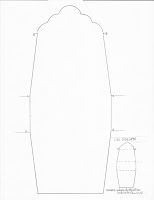
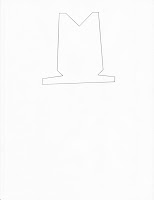
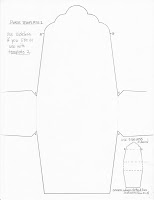
You can add a little picture of where to score on the same page as your template to save scanning & save paper (see that little doodle in the bottom right corner?)
Labeling:
I prefer not to label parts inside the template or to write on folds (so that people can just print out templates directly onto the paper for the finished project) but I've been thinking lately that I might make tutorials or instruction sheets to go with my templates, so they aren't confusing.
Easy ways to make templates:
 Things you can trace to make templates:
Things you can trace to make templates:- If you save the outlines (positive or negative) of die-cut projects you can trace them later. (See this purse box project here.)
- Any box or packaging that you like the shape of can be pulled apart & traced to make your own template
Thanks so much for checkin' this out. If you have any questions (or I need to explain anything better in here) I'd love to hear from you! :0)
P.S. Tutorials to follow in this Template 101 series:
- Altering existing templates for your personal use
- Tips for using templates
- Publishing your templates (on SCS)



















16 comments:
Wow, Mel, you must have been reading my mind. I was wondering how you did this. I will have to study it real well.
Mel: If you don't write a papercrafting book, you are nuts. Think of the moola you could make. I am serious....you should do this...in my lifetime please! You are sooooo talented.
Mary
www.primitiveseasons.blogspot.com
Thanks so much for these tips! And I totally agree with Mary that you should write a book!!
Lisa
www.lisabeesponderings.blogspot.com
Wow!! You surely shed some light on this! I so appreciate all the hard work everyone does when sharing these awesome templates! Thanks!!!!!!!! Nancy
My scanner and computer don't talk to each other for now. No copier. I feel like I am living in stone age.
Anyways, here is how I create my templates. I go searching for an image I like. Take out the details, resize to my liking, print and cut out. I save both pieces, just in case I need to do reverse masking, sponging etc.
I am liking the book idea too. I will do the cleanup work for you if you like and you can give me 50% of the profit. LOL!
Thank you for your tips.
Thankyou for sharing your experise :)
You are a gem!!!
Have a great day!
Kewl! TFS!
Mel, I hope you don't mind but I have an award for you on my blog. I am sure that you receive loads of awards, but I just wanted to say a big thanks for the time and effort that you put into each and every post.
Michelle
Wow! Your tutorials blow me away. This one is awesome. I'll join the crowd and say you should write a book.
Neat! Thanks for sharing your ideas with us! This is craziness, I couldn't do it! Thank goodness for you! TFS.
Mel, when do you sleep? You are AMAZING! I agree with primitive seasons above -- you need to write a papercrafting book!
You are a genius Mel!!! At the present I am in the "abc" stage when it comes to making templates. lol I really appreciate you for taking the time and sharing different methods. Thank you for sharing:)
HOLY ________ !!! This is amazing!!
YOu are a genious!
Mel, you never stop amazing me! You are one crafty gal I must say! I look forward to your blog everyday! Thank you so much for the inspiration!!
Hugs,
Joani
Ooh, awesome tutorial, Mel! I need to try this! It's always fun to create your own stuff. . .I agree, with "primitive seasons". .you should compile all your templates and download them on CD and sell them!
As always. . .thank you for sharing all your innovative ideas!!
Maria
Hey woman, been missing ya.
Another great post for us "Mel stalkers".
Love it.
Thanks
A.M.
Hugs
Tonniece
Post a Comment